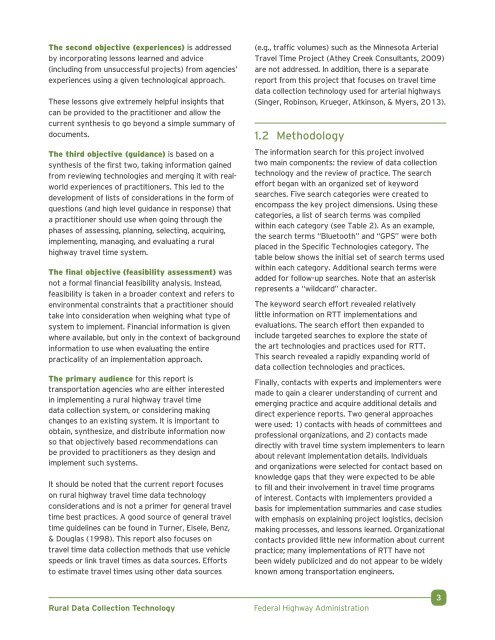Rural Data Collection Technology - FHWA Operations - U.S. ...
Rural Data Collection Technology - FHWA Operations - U.S. ...
Rural Data Collection Technology - FHWA Operations - U.S. ...
- No tags were found...
You also want an ePaper? Increase the reach of your titles
YUMPU automatically turns print PDFs into web optimized ePapers that Google loves.
The second objective (experiences) is addressedby incorporating lessons learned and advice(including from unsuccessful projects) from agencies’experiences using a given technological approach.These lessons give extremely helpful insights thatcan be provided to the practitioner and allow thecurrent synthesis to go beyond a simple summary ofdocuments.The third objective (guidance) is based on asynthesis of the first two, taking information gainedfrom reviewing technologies and merging it with realworldexperiences of practitioners. This led to thedevelopment of lists of considerations in the form ofquestions (and high level guidance in response) thata practitioner should use when going through thephases of assessing, planning, selecting, acquiring,implementing, managing, and evaluating a ruralhighway travel time system.The final objective (feasibility assessment) wasnot a formal financial feasibility analysis. Instead,feasibility is taken in a broader context and refers toenvironmental constraints that a practitioner shouldtake into consideration when weighing what type ofsystem to implement. Financial information is givenwhere available, but only in the context of backgroundinformation to use when evaluating the entirepracticality of an implementation approach.The primary audience for this report istransportation agencies who are either interestedin implementing a rural highway travel timedata collection system, or considering makingchanges to an existing system. It is important toobtain, synthesize, and distribute information nowso that objectively based recommendations canbe provided to practitioners as they design andimplement such systems.It should be noted that the current report focuseson rural highway travel time data technologyconsiderations and is not a primer for general traveltime best practices. A good source of general traveltime guidelines can be found in Turner, Eisele, Benz,& Douglas (1998). This report also focuses ontravel time data collection methods that use vehiclespeeds or link travel times as data sources. Effortsto estimate travel times using other data sources(e.g., traffic volumes) such as the Minnesota ArterialTravel Time Project (Athey Creek Consultants, 2009)are not addressed. In addition, there is a separatereport from this project that focuses on travel timedata collection technology used for arterial highways(Singer, Robinson, Krueger, Atkinson, & Myers, 2013).1.2 MethodologyThe information search for this project involvedtwo main components: the review of data collectiontechnology and the review of practice. The searcheffort began with an organized set of keywordsearches. Five search categories were created toencompass the key project dimensions. Using thesecategories, a list of search terms was compiledwithin each category (see Table 2). As an example,the search terms “Bluetooth” and “GPS” were bothplaced in the Specific Technologies category. Thetable below shows the initial set of search terms usedwithin each category. Additional search terms wereadded for follow-up searches. Note that an asteriskrepresents a “wildcard” character.The keyword search effort revealed relativelylittle information on RTT implementations andevaluations. The search effort then expanded toinclude targeted searches to explore the state ofthe art technologies and practices used for RTT.This search revealed a rapidly expanding world ofdata collection technologies and practices.Finally, contacts with experts and implementers weremade to gain a clearer understanding of current andemerging practice and acquire additional details anddirect experience reports. Two general approacheswere used: 1) contacts with heads of committees andprofessional organizations, and 2) contacts madedirectly with travel time system implementers to learnabout relevant implementation details. Individualsand organizations were selected for contact based onknowledge gaps that they were expected to be ableto fill and their involvement in travel time programsof interest. Contacts with implementers provided abasis for implementation summaries and case studieswith emphasis on explaining project logistics, decisionmaking processes, and lessons learned. Organizationalcontacts provided little new information about currentpractice; many implementations of RTT have notbeen widely publicized and do not appear to be widelyknown among transportation engineers.<strong>Rural</strong> <strong>Data</strong> <strong>Collection</strong> <strong>Technology</strong>Federal Highway Administration3
















